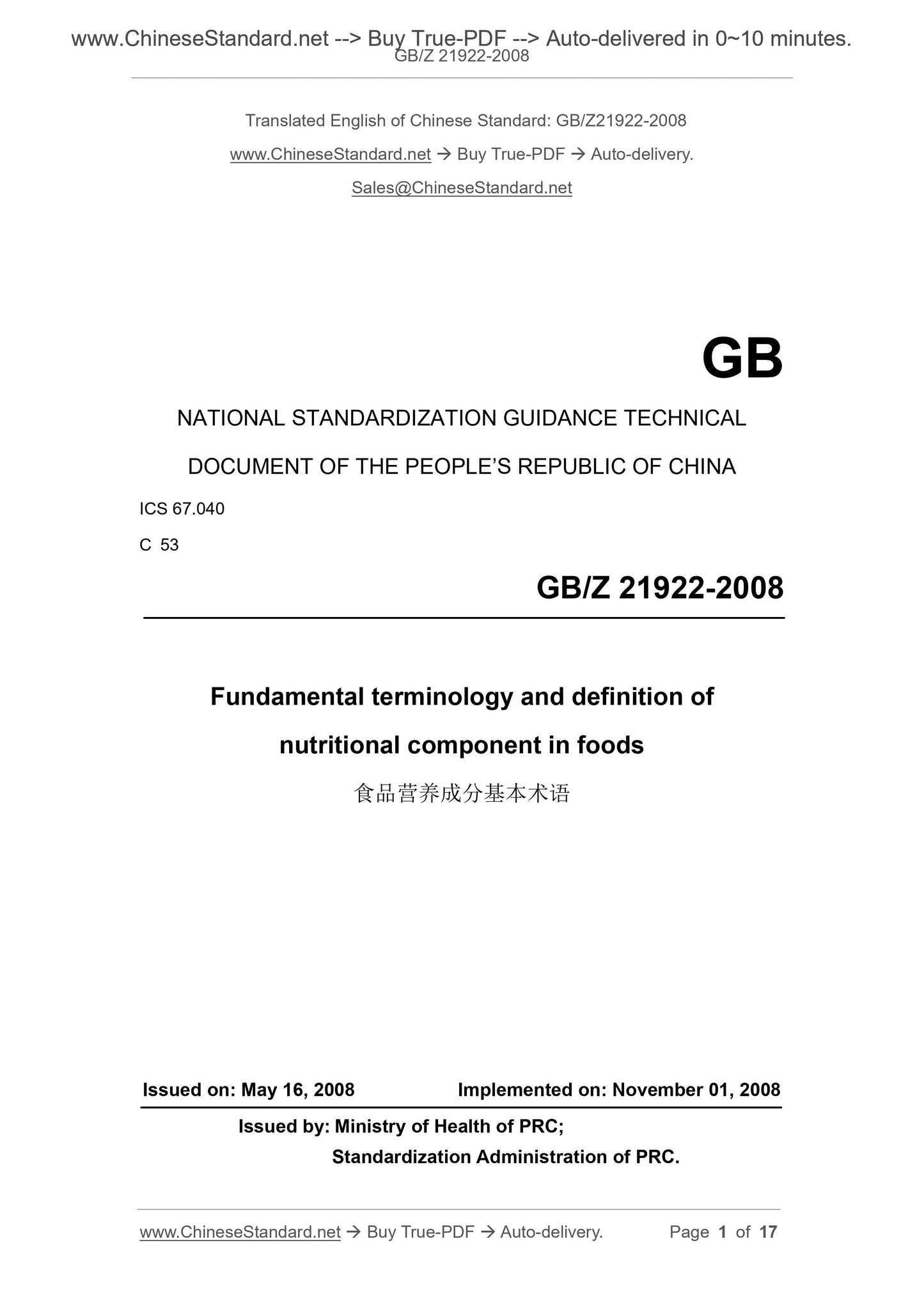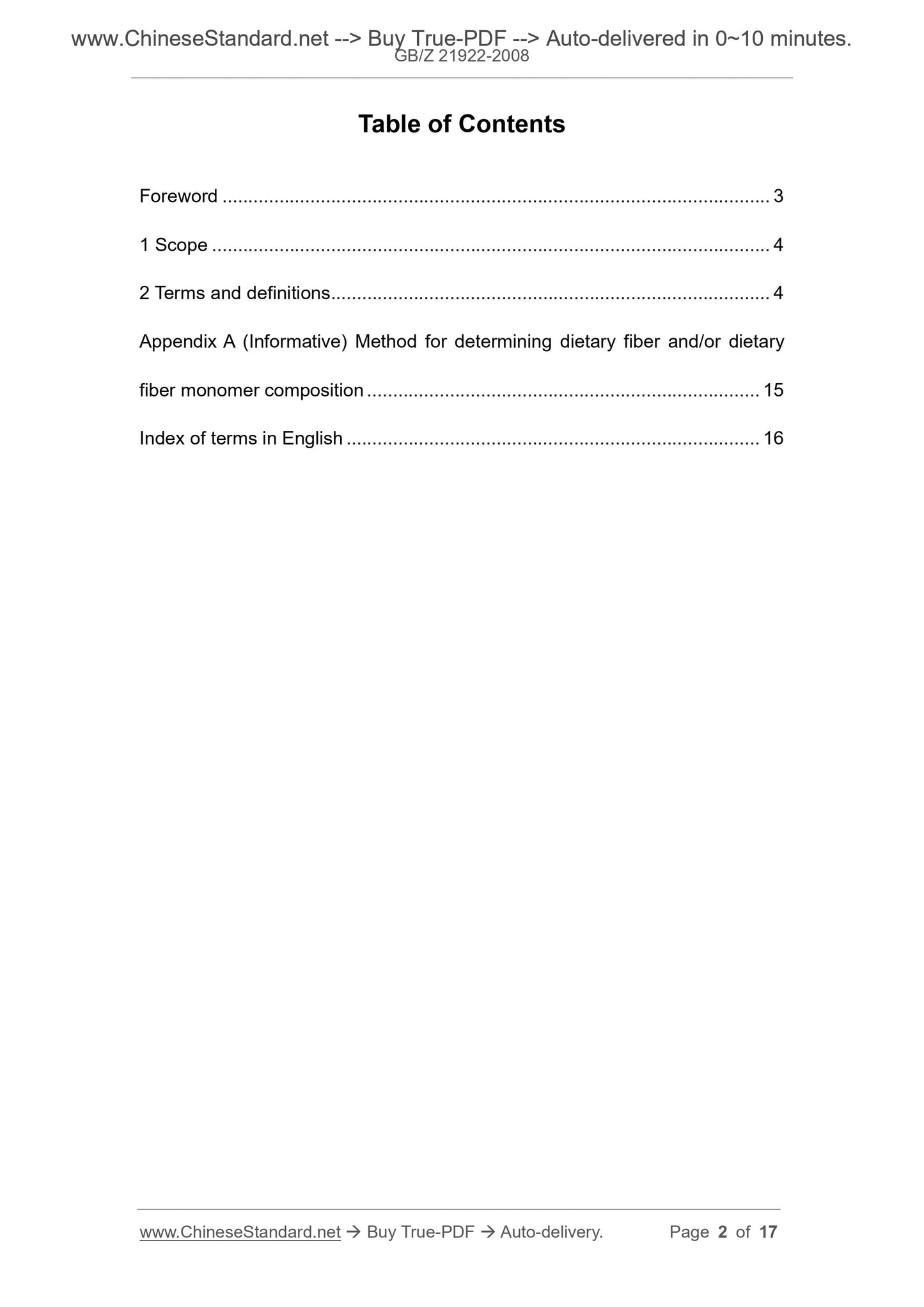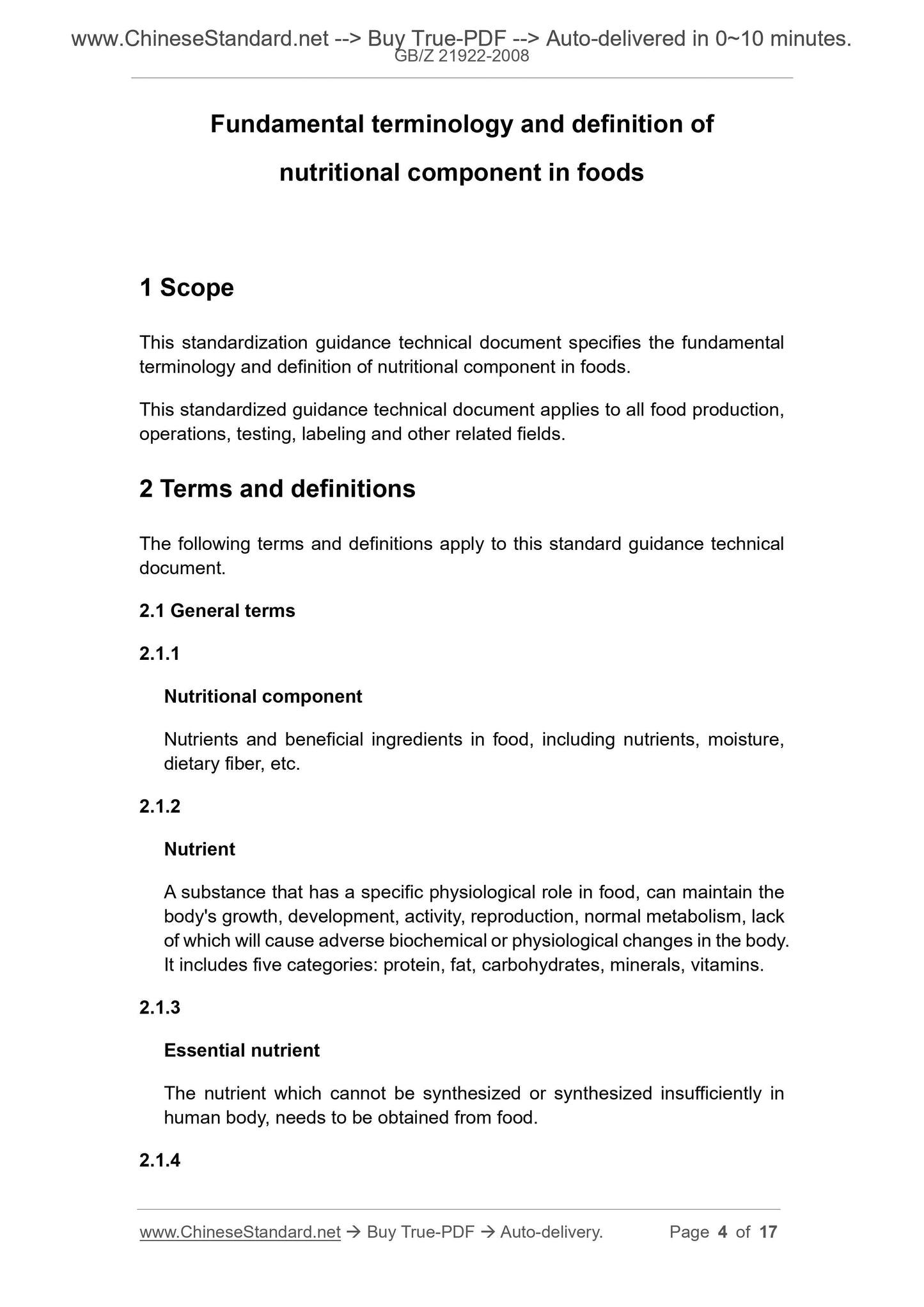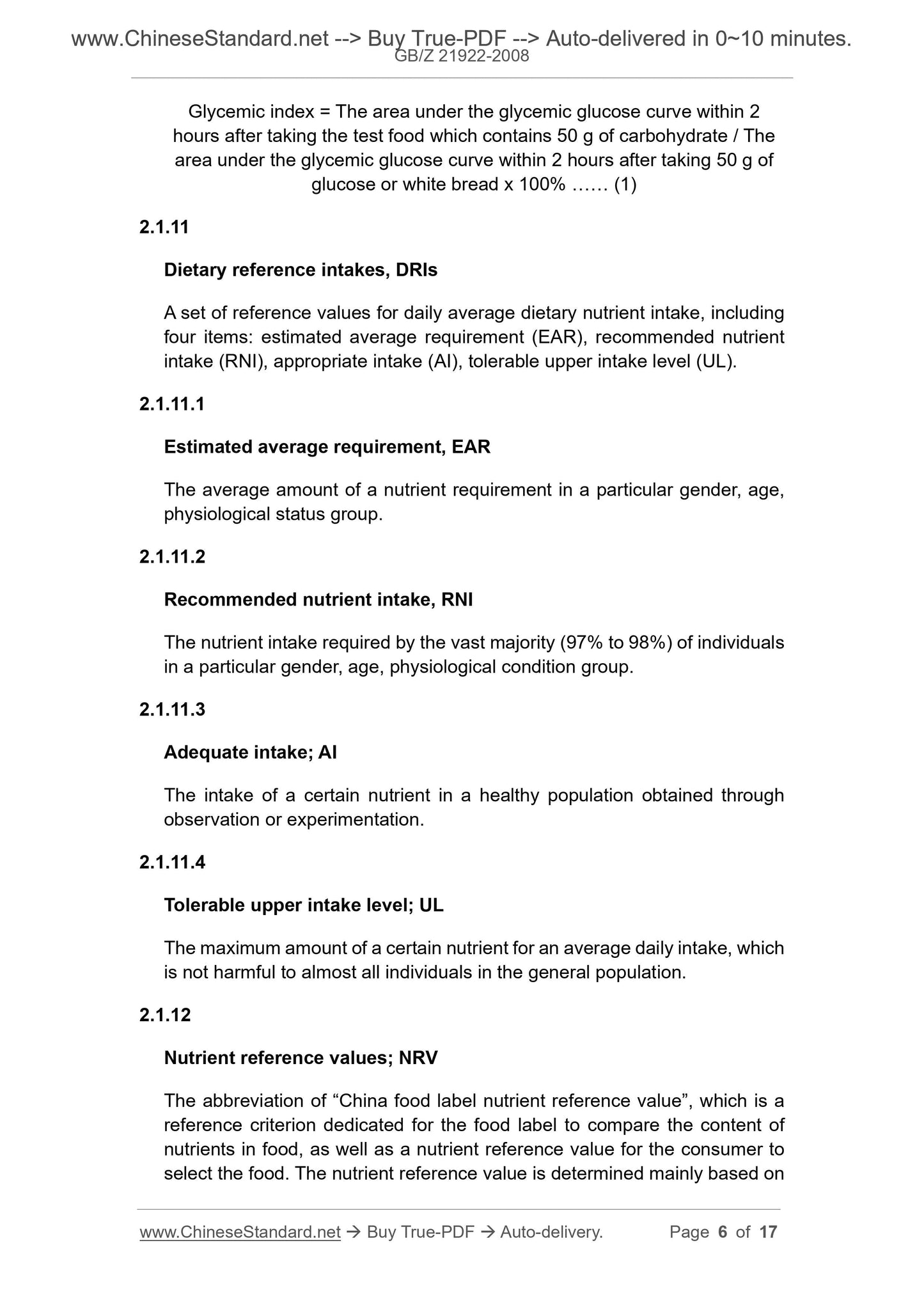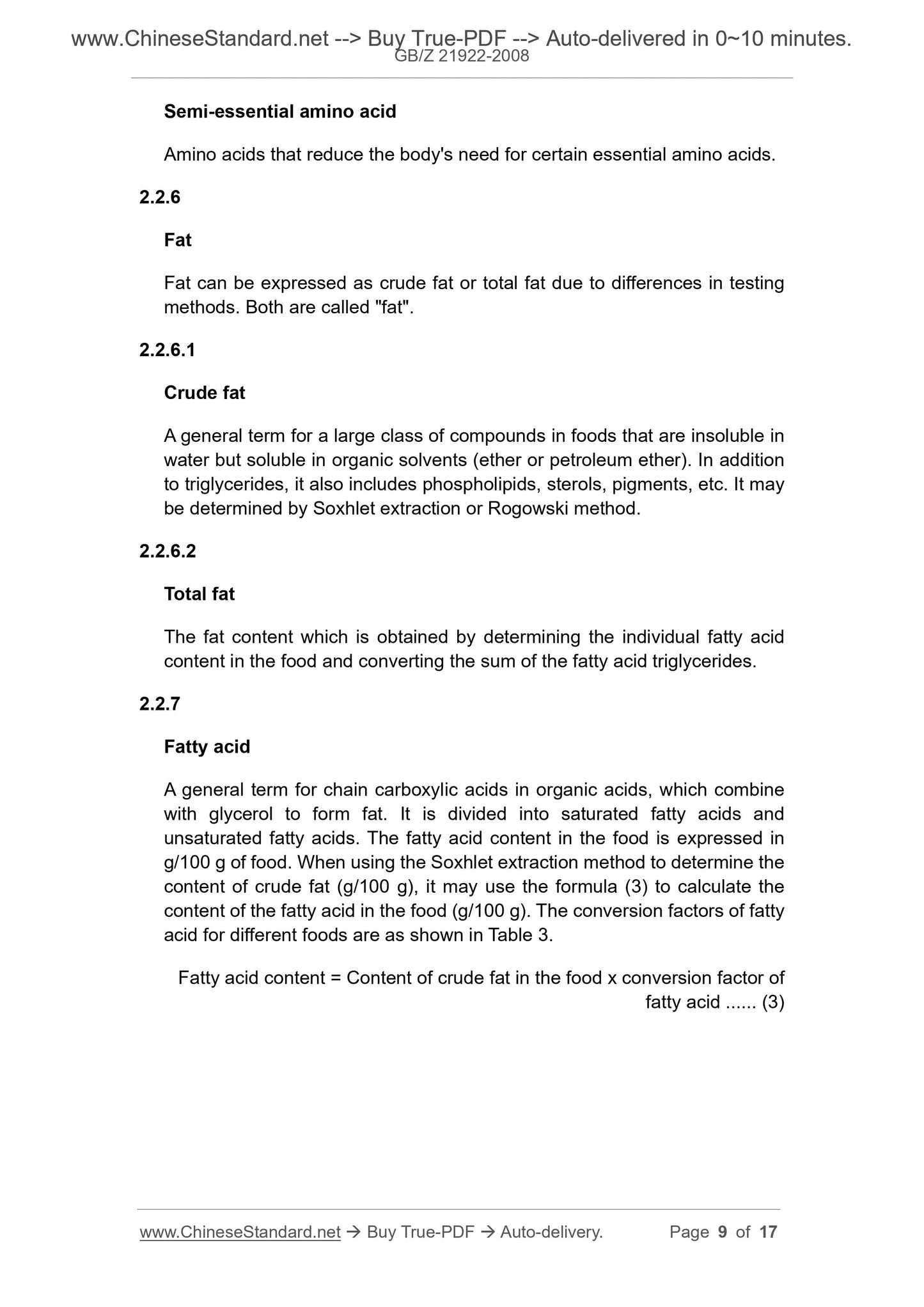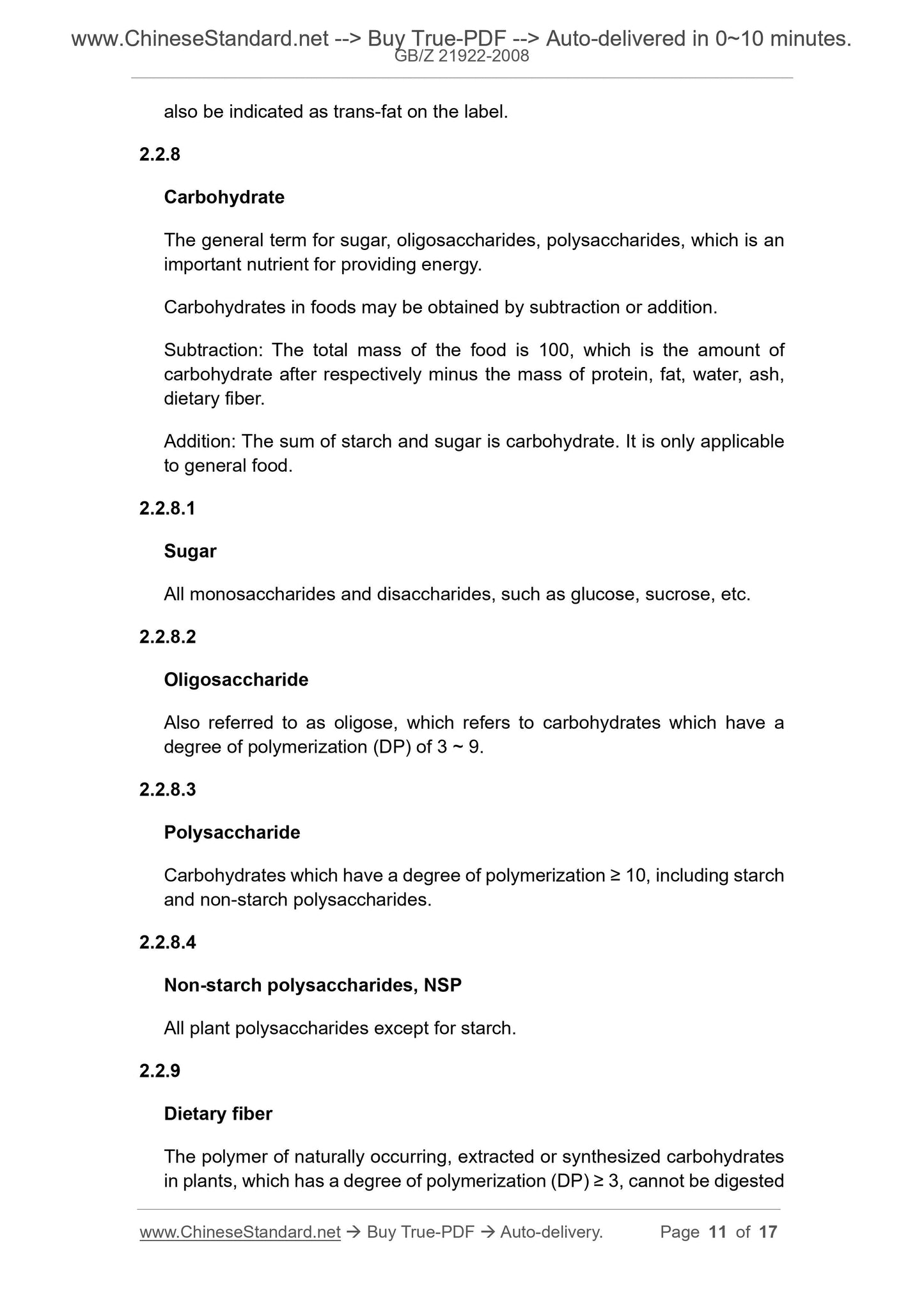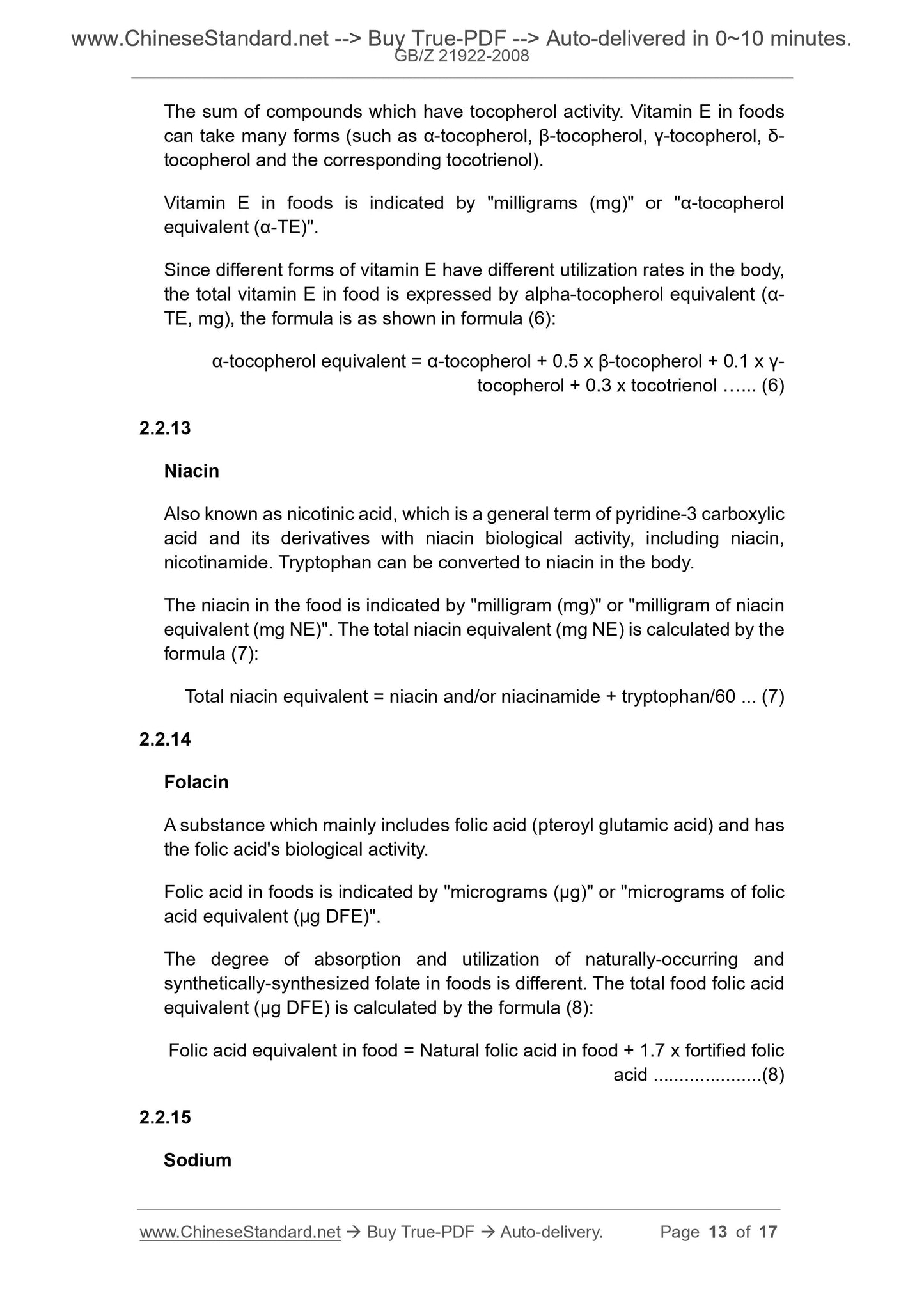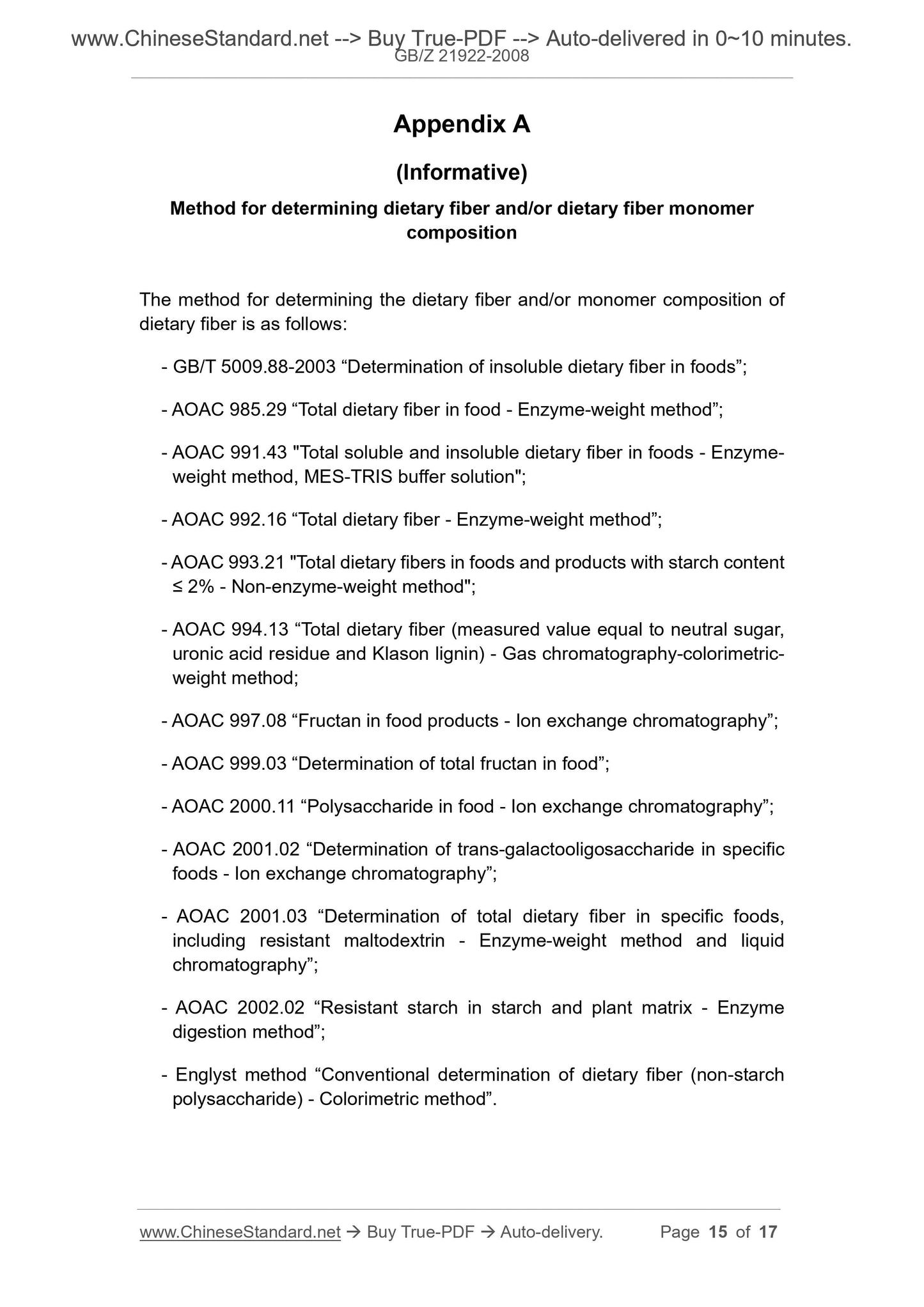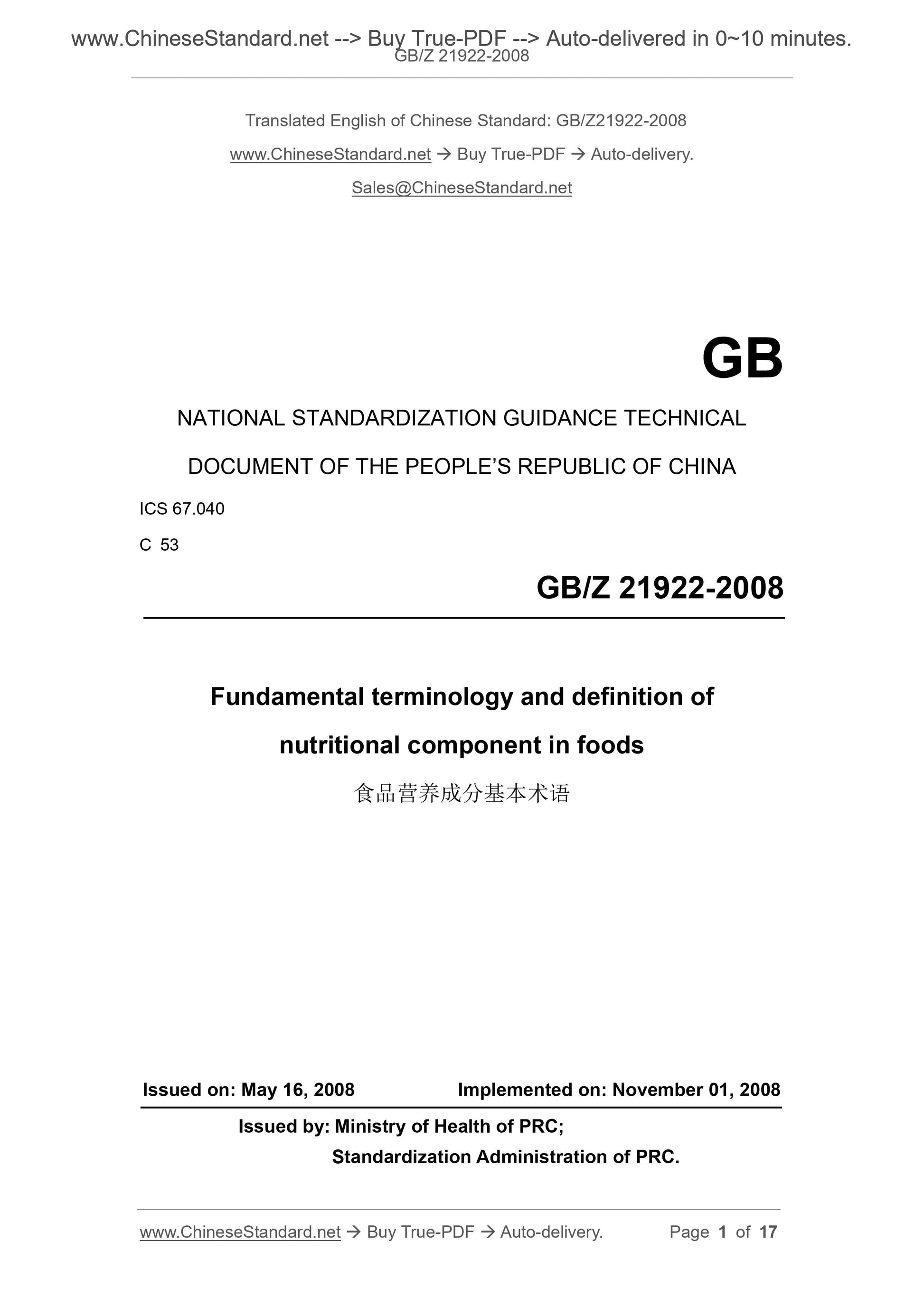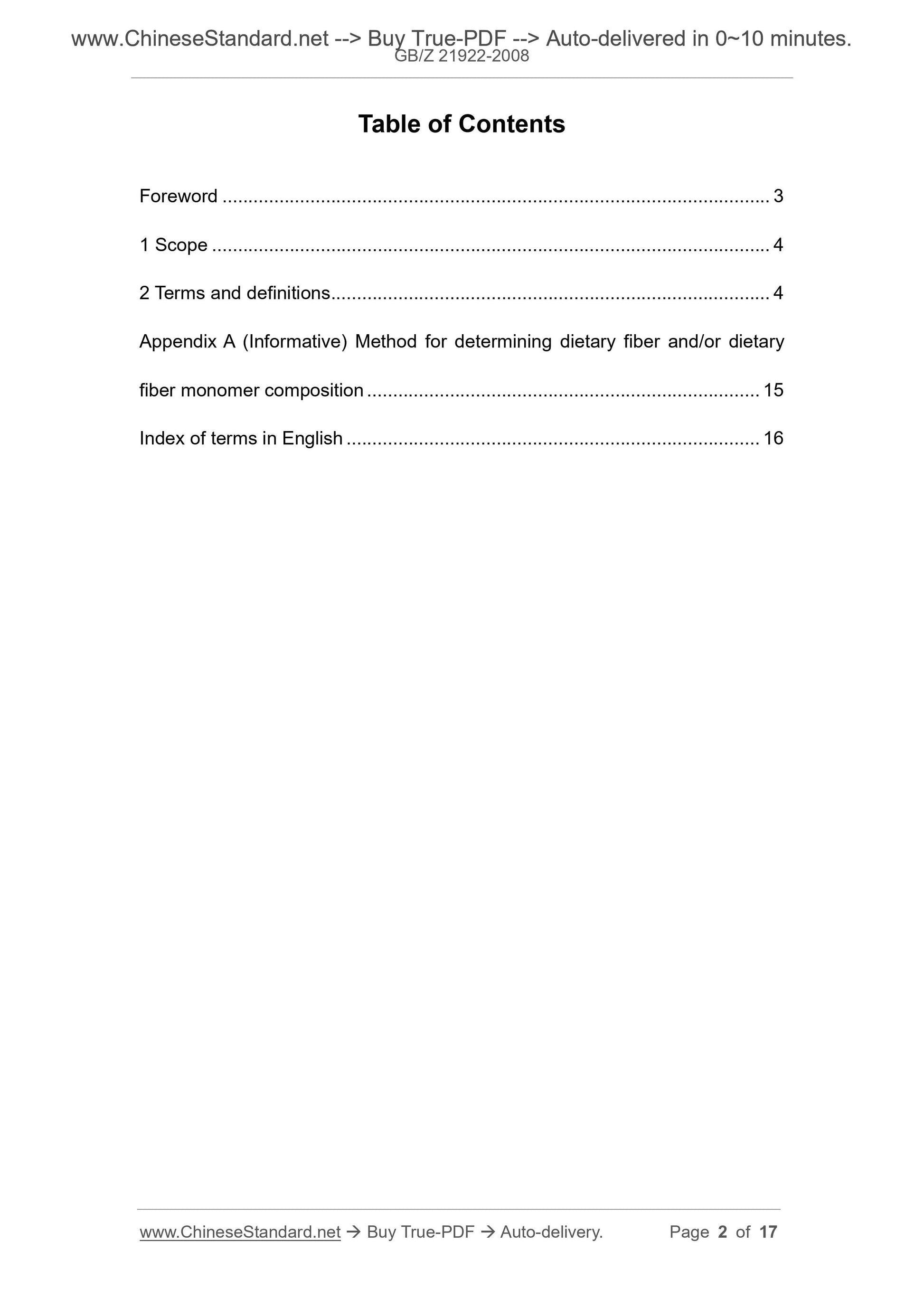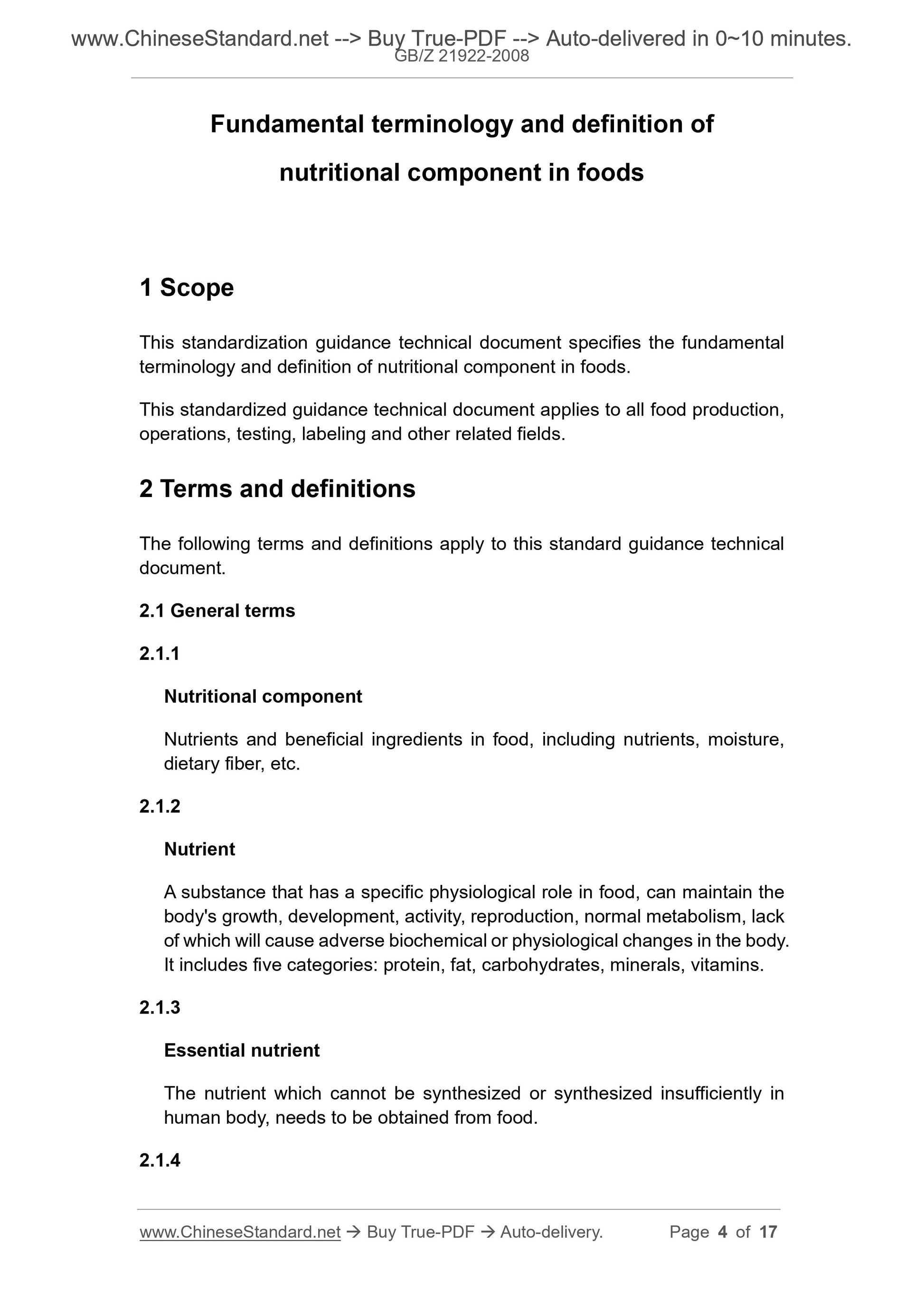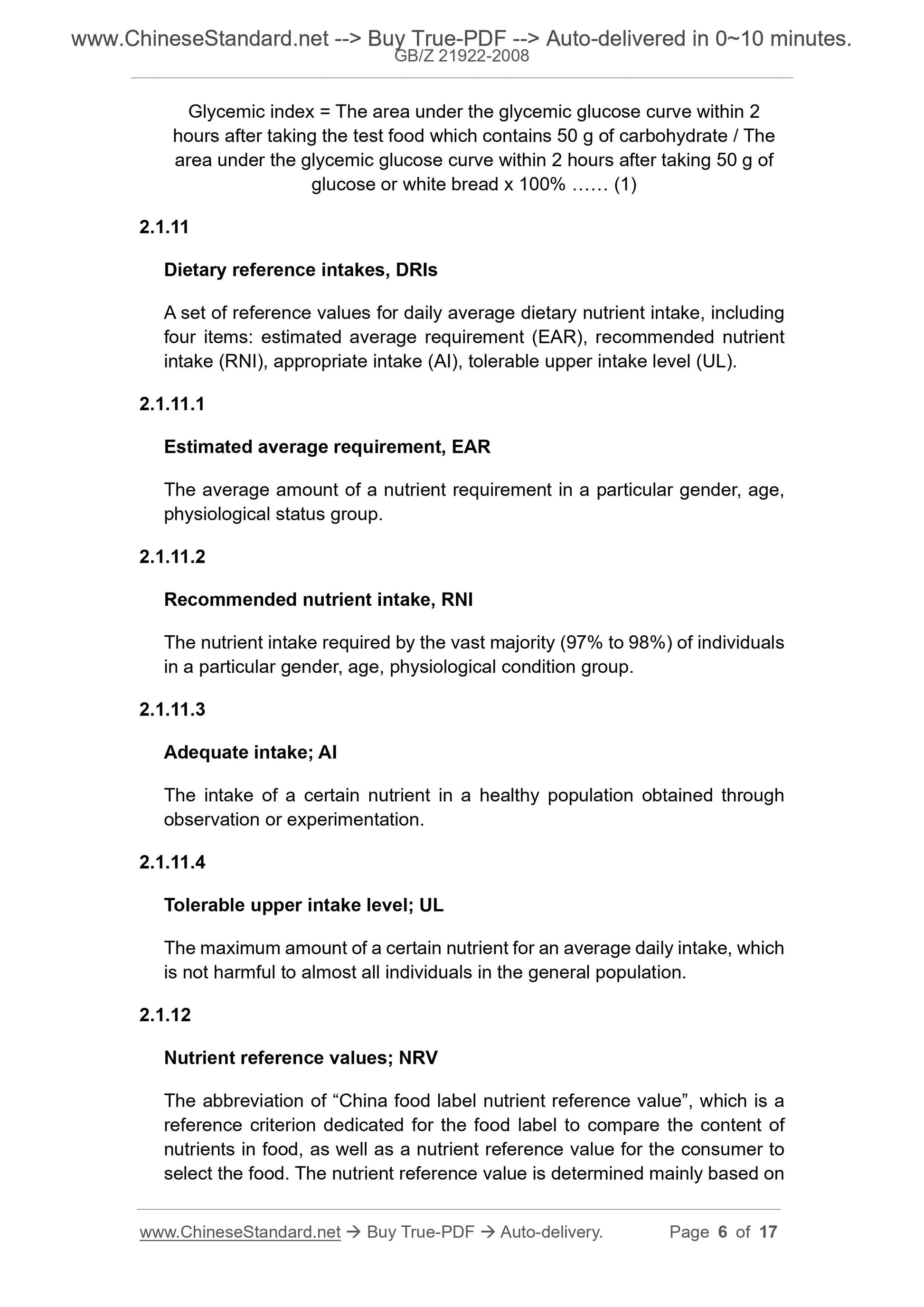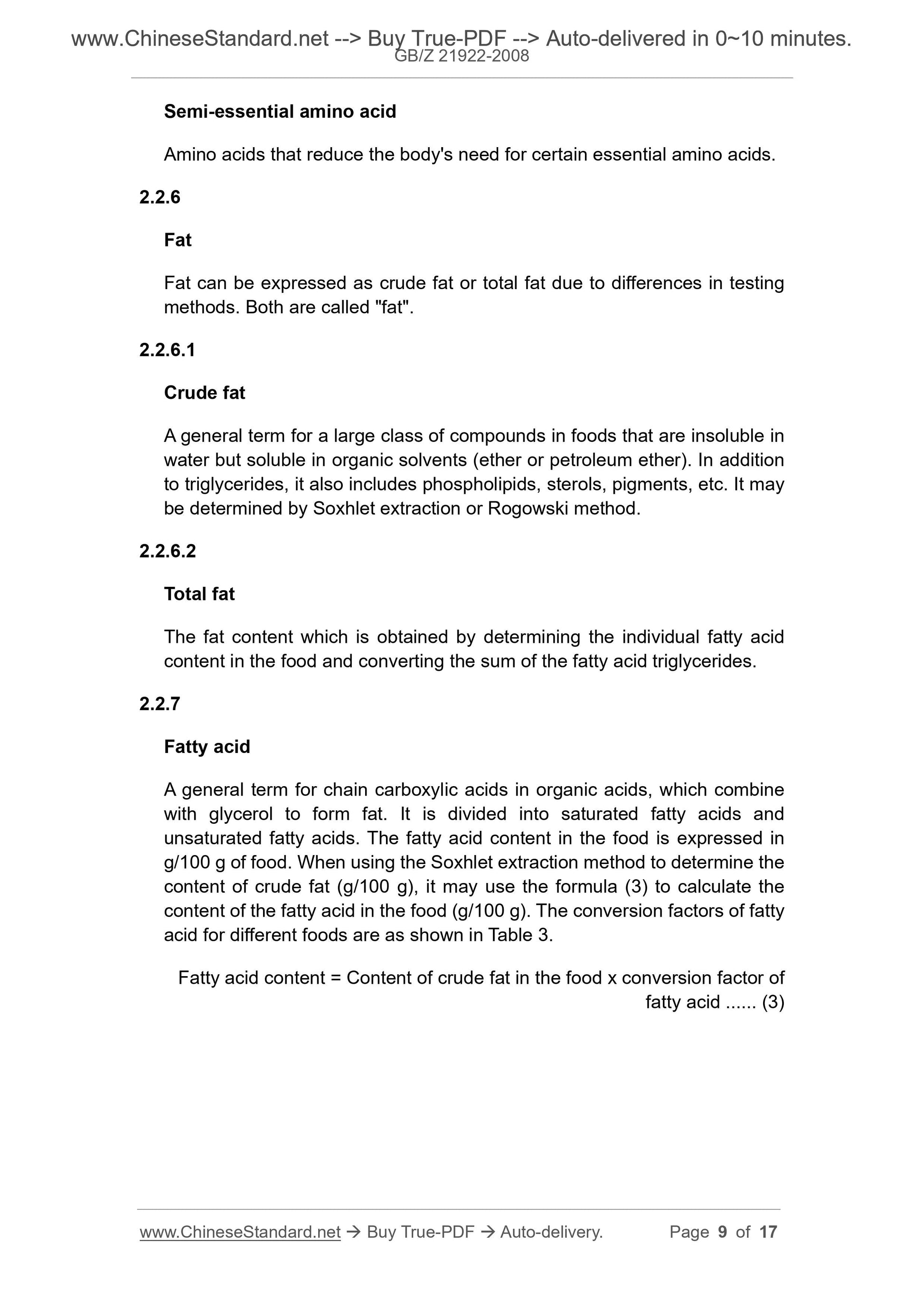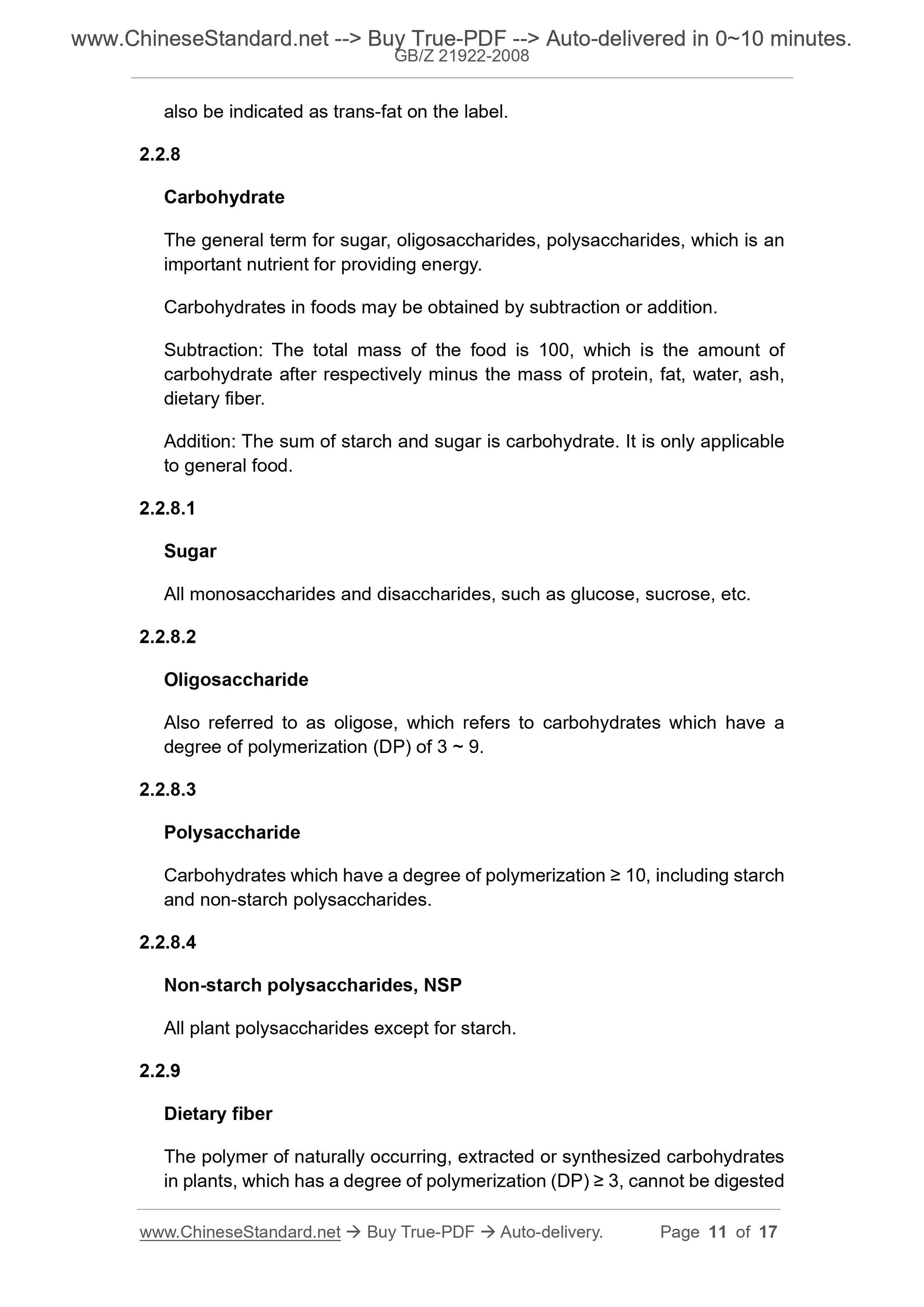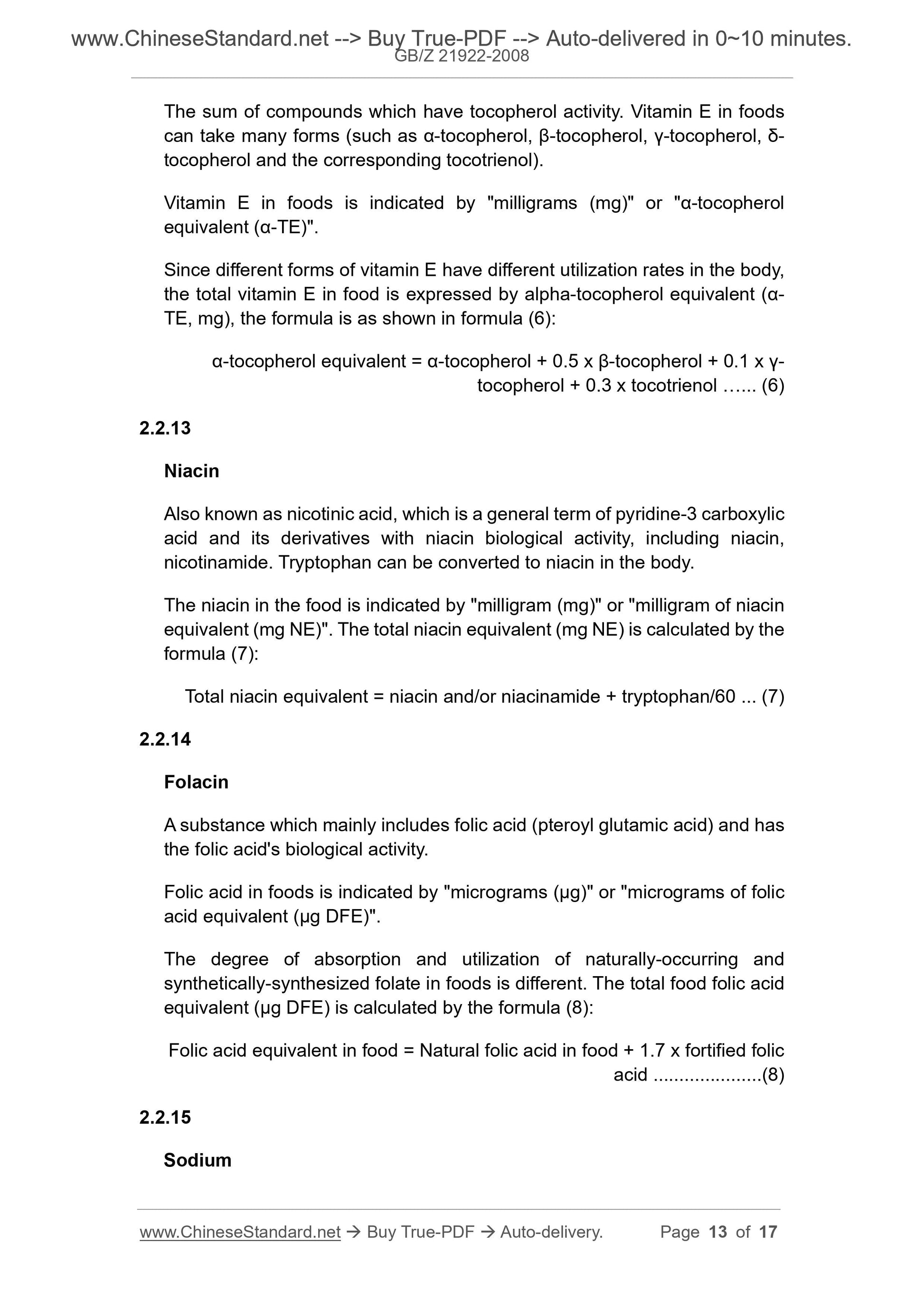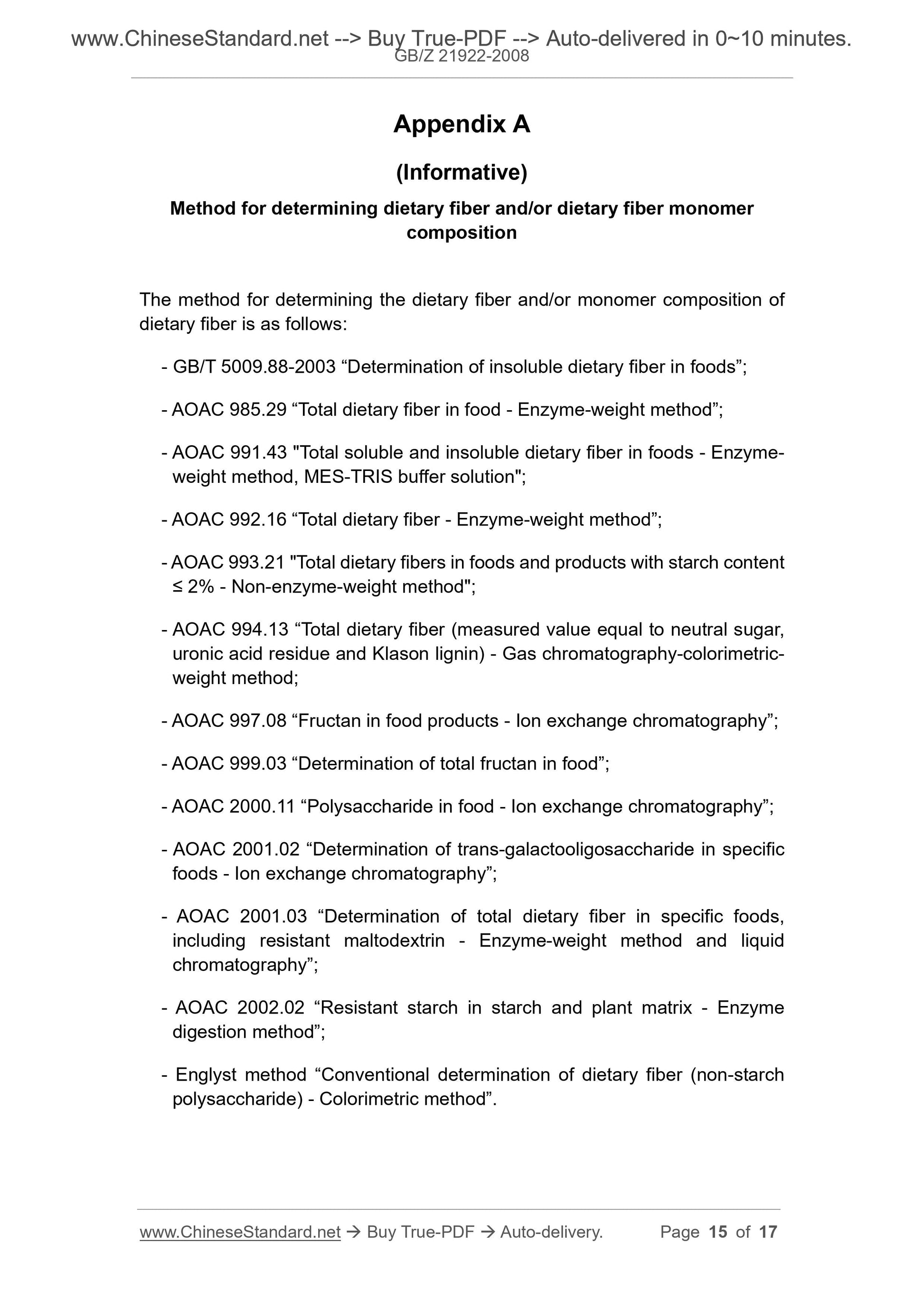1
/
of
8
PayPal, credit cards. Download editable-PDF and invoice in 1 second!
GB/Z 21922-2008 English PDF (GBZ21922-2008)
GB/Z 21922-2008 English PDF (GBZ21922-2008)
Regular price
$70.00 USD
Regular price
Sale price
$70.00 USD
Unit price
/
per
Shipping calculated at checkout.
Couldn't load pickup availability
Delivery: 3 seconds. Download true-PDF + Invoice.
Get QUOTATION in 1-minute: Click GB/Z 21922-2008
Historical versions: GB/Z 21922-2008
Preview True-PDF (Reload/Scroll if blank)
GB/Z 21922-2008: Fundamental terminology and definition of nutritional component in foods
GB/Z 21922-2008
NATIONAL STANDARDIZATION GUIDANCE TECHNICAL
DOCUMENT OF THE PEOPLE’S REPUBLIC OF CHINA
ICS 67.040
C 53
Fundamental terminology and definition of
nutritional component in foods
ISSUED ON: MAY 16, 2008
IMPLEMENTED ON: NOVEMBER 01, 2008
Issued by: Ministry of Health of PRC;
Standardization Administration of PRC.
Table of Contents
Foreword ... 3
1 Scope ... 4
2 Terms and definitions ... 4
Appendix A (Informative) Method for determining dietary fiber and/or dietary
fiber monomer composition ... 15
Index of terms in English ... 16
Fundamental terminology and definition of
nutritional component in foods
1 Scope
This standardization guidance technical document specifies the fundamental
terminology and definition of nutritional component in foods.
This standardized guidance technical document applies to all food production,
operations, testing, labeling and other related fields.
2 Terms and definitions
The following terms and definitions apply to this standard guidance technical
document.
2.1 General terms
2.1.1
Nutritional component
Nutrients and beneficial ingredients in food, including nutrients, moisture,
dietary fiber, etc.
2.1.2
Nutrient
A substance that has a specific physiological role in food, can maintain the
body's growth, development, activity, reproduction, normal metabolism, lack
of which will cause adverse biochemical or physiological changes in the body.
It includes five categories: protein, fat, carbohydrates, minerals, vitamins.
2.1.3
Essential nutrient
The nutrient which cannot be synthesized or synthesized insufficiently in
human body, needs to be obtained from food.
2.1.4
Glycemic index = The area under the glycemic glucose curve within 2
hours after taking the test food which contains 50 g of carbohydrate / The
area under the glycemic glucose curve within 2 hours after taking 50 g of
glucose or white bread x 100% …… (1)
2.1.11
Dietary reference intakes, DRIs
A set of reference values for daily average dietary nutrient intake, including
four items: estimated average requirement (EAR), recommended nutrient
intake (RNI), appropriate intake (AI), tolerable upper intake level (UL).
2.1.11.1
Estimated average requirement, EAR
The average amount of a nutrient requirement in a particular gender, age,
physiological status group.
2.1.11.2
Recommended nutrient intake, RNI
The nutrient intake required by the vast majority (97% to 98%) of individuals
in a particular gender, age, physiological condition group.
2.1.11.3
Adequate intake; AI
The intake of a certain nutrient in a healthy population obtained through
observation or experimentation.
2.1.11.4
Tolerable upper intake level; UL
The maximum amount of a certain nutrient for an average daily intake, which
is not harmful to almost all individuals in the general population.
2.1.12
Nutrient reference values; NRV
The abbreviation of “China food label nutrient reference value”, which is a
reference criterion dedicated for the food label to compare the content of
nutrients in food, as well as a nutrient reference value for the consumer to
select the food. The nutrient reference value is determined mainly based on
Semi-essential amino acid
Amino acids that reduce the body's need for certain essential amino acids.
2.2.6
Fat
Fat can be expressed as crude fat or total fat due to differences in testing
methods. Both are called "fat".
2.2.6.1
Crude fat
A general term for a large class of compounds in foods that are insoluble in
water but soluble in organic solvents (ether or petroleum ether). In addition
to triglycerides, it also includes phospholipids, sterols, pigments, etc. It may
be determined by Soxhlet extraction or Rogowski method.
2.2.6.2
Total fat
The fat content which is obtained by determining the individual fatty acid
content in the food and converting the sum of the fatty acid triglycerides.
2.2.7
Fatty acid
A general term for chain carboxylic acids in organic acids, which combine
with glycerol to form fat. It is divided into saturated fatty acids and
unsaturated fatty acids. The fatty acid content in the food is expressed in
g/100 g of food. When using the Soxhlet extraction method to determine the
content of crude fat (g/100 g), it may use the formula (3) to calculate the
content of the fatty acid in the food (g/100 g). The conversion factors of fatty
acid for different foods are as shown in Table 3.
Fatty acid content = Content of crude fat in the food x conversion factor of
fatty acid ... (3)
also be indicated as trans-fat on the label.
2.2.8
Carbohydrate
The general term for sugar, oligosaccharides, polysaccharides, which is an
important nutrient for providing energy.
Carbohydrates in foods may be obtained by subtraction or addition.
Subtraction: The total mass of the food is 100, which is the amount of
carbohydrate after respectively minus the mass of protein, fat, water, ash,
dietary fiber.
Addition: The sum of starch and sugar is carbohydrate. It is only applicable
to general food.
2.2.8.1
Sugar
All monosaccharides and disaccharides, such as glucose, sucrose, etc.
2.2.8.2
Oligosaccharide
Also referred to as oligose, which refers to carbohydrates which have a
degree of polymerization (DP) of 3 ~ 9.
2.2.8.3
Polysaccharide
Carbohydrates which have a degree of polymerization ≥ 10, including starch
and non-starch polysaccharides.
2.2.8.4
Non-starch polysaccharides, NSP
All plant polysaccharides except for starch.
2.2.9
Dietary fiber
The polymer of naturally occurring, extracted or synthesized carbohydrates
in plants, which has a degree of polymerization (DP) ≥ 3, cannot be digested
The sum of compounds which have tocopherol activity. Vitamin E in foods
can take many forms (such as α-tocopherol, β-tocopherol, γ-tocopherol, δ-
tocopherol and the corresponding tocotrienol).
Vitamin E in foods is indicated by "milligrams (mg)" or "α-tocopherol
equivalent (α-TE)".
Since different forms of vitamin E have different utilization rates in the body,
the total vitamin E in food is expressed by alpha-tocopherol equivalent (α-
TE, mg), the formula is as shown in formula (6):
α-tocopherol equivalent = α-tocopherol + 0.5 x β-tocopherol + 0.1 x γ-
tocopherol + 0.3 x tocotrienol …... (6)
2.2.13
Niacin
Also known as nicotinic acid, which is a general term of pyridine-3 carboxylic
acid and its derivatives with niacin biological activity, including niacin,
nicotinamide. Tryptophan can be converted to niacin in the body.
The niacin in the food is indicated by "milligram (mg)" or "milligram of niacin
equivalent (mg NE)". The total niacin equivalent (mg NE) is calculated by the
formula (7):
Total niacin equivalent = niacin and/or niacinamide + tryptophan/60 ... (7)
2.2.14
Folacin
A substance which mainly includes folic acid (pteroyl glutamic acid) and has
the folic acid's biological activity.
Folic acid in foods is indicated by "micrograms (μg)" or "micrograms of folic
acid equivalent (μg DFE)".
The degree of absorption and utilization of naturally-occurring and
synthetically-synthesized folate in foods is different. The total food folic acid
equivalent (μg DFE) is calculated by the formula (8):
Folic acid equivalent in food = Natural folic acid in food + 1.7 x fortified folic
acid ...(8)
2.2.15
Sodiu...
Get QUOTATION in 1-minute: Click GB/Z 21922-2008
Historical versions: GB/Z 21922-2008
Preview True-PDF (Reload/Scroll if blank)
GB/Z 21922-2008: Fundamental terminology and definition of nutritional component in foods
GB/Z 21922-2008
NATIONAL STANDARDIZATION GUIDANCE TECHNICAL
DOCUMENT OF THE PEOPLE’S REPUBLIC OF CHINA
ICS 67.040
C 53
Fundamental terminology and definition of
nutritional component in foods
ISSUED ON: MAY 16, 2008
IMPLEMENTED ON: NOVEMBER 01, 2008
Issued by: Ministry of Health of PRC;
Standardization Administration of PRC.
Table of Contents
Foreword ... 3
1 Scope ... 4
2 Terms and definitions ... 4
Appendix A (Informative) Method for determining dietary fiber and/or dietary
fiber monomer composition ... 15
Index of terms in English ... 16
Fundamental terminology and definition of
nutritional component in foods
1 Scope
This standardization guidance technical document specifies the fundamental
terminology and definition of nutritional component in foods.
This standardized guidance technical document applies to all food production,
operations, testing, labeling and other related fields.
2 Terms and definitions
The following terms and definitions apply to this standard guidance technical
document.
2.1 General terms
2.1.1
Nutritional component
Nutrients and beneficial ingredients in food, including nutrients, moisture,
dietary fiber, etc.
2.1.2
Nutrient
A substance that has a specific physiological role in food, can maintain the
body's growth, development, activity, reproduction, normal metabolism, lack
of which will cause adverse biochemical or physiological changes in the body.
It includes five categories: protein, fat, carbohydrates, minerals, vitamins.
2.1.3
Essential nutrient
The nutrient which cannot be synthesized or synthesized insufficiently in
human body, needs to be obtained from food.
2.1.4
Glycemic index = The area under the glycemic glucose curve within 2
hours after taking the test food which contains 50 g of carbohydrate / The
area under the glycemic glucose curve within 2 hours after taking 50 g of
glucose or white bread x 100% …… (1)
2.1.11
Dietary reference intakes, DRIs
A set of reference values for daily average dietary nutrient intake, including
four items: estimated average requirement (EAR), recommended nutrient
intake (RNI), appropriate intake (AI), tolerable upper intake level (UL).
2.1.11.1
Estimated average requirement, EAR
The average amount of a nutrient requirement in a particular gender, age,
physiological status group.
2.1.11.2
Recommended nutrient intake, RNI
The nutrient intake required by the vast majority (97% to 98%) of individuals
in a particular gender, age, physiological condition group.
2.1.11.3
Adequate intake; AI
The intake of a certain nutrient in a healthy population obtained through
observation or experimentation.
2.1.11.4
Tolerable upper intake level; UL
The maximum amount of a certain nutrient for an average daily intake, which
is not harmful to almost all individuals in the general population.
2.1.12
Nutrient reference values; NRV
The abbreviation of “China food label nutrient reference value”, which is a
reference criterion dedicated for the food label to compare the content of
nutrients in food, as well as a nutrient reference value for the consumer to
select the food. The nutrient reference value is determined mainly based on
Semi-essential amino acid
Amino acids that reduce the body's need for certain essential amino acids.
2.2.6
Fat
Fat can be expressed as crude fat or total fat due to differences in testing
methods. Both are called "fat".
2.2.6.1
Crude fat
A general term for a large class of compounds in foods that are insoluble in
water but soluble in organic solvents (ether or petroleum ether). In addition
to triglycerides, it also includes phospholipids, sterols, pigments, etc. It may
be determined by Soxhlet extraction or Rogowski method.
2.2.6.2
Total fat
The fat content which is obtained by determining the individual fatty acid
content in the food and converting the sum of the fatty acid triglycerides.
2.2.7
Fatty acid
A general term for chain carboxylic acids in organic acids, which combine
with glycerol to form fat. It is divided into saturated fatty acids and
unsaturated fatty acids. The fatty acid content in the food is expressed in
g/100 g of food. When using the Soxhlet extraction method to determine the
content of crude fat (g/100 g), it may use the formula (3) to calculate the
content of the fatty acid in the food (g/100 g). The conversion factors of fatty
acid for different foods are as shown in Table 3.
Fatty acid content = Content of crude fat in the food x conversion factor of
fatty acid ... (3)
also be indicated as trans-fat on the label.
2.2.8
Carbohydrate
The general term for sugar, oligosaccharides, polysaccharides, which is an
important nutrient for providing energy.
Carbohydrates in foods may be obtained by subtraction or addition.
Subtraction: The total mass of the food is 100, which is the amount of
carbohydrate after respectively minus the mass of protein, fat, water, ash,
dietary fiber.
Addition: The sum of starch and sugar is carbohydrate. It is only applicable
to general food.
2.2.8.1
Sugar
All monosaccharides and disaccharides, such as glucose, sucrose, etc.
2.2.8.2
Oligosaccharide
Also referred to as oligose, which refers to carbohydrates which have a
degree of polymerization (DP) of 3 ~ 9.
2.2.8.3
Polysaccharide
Carbohydrates which have a degree of polymerization ≥ 10, including starch
and non-starch polysaccharides.
2.2.8.4
Non-starch polysaccharides, NSP
All plant polysaccharides except for starch.
2.2.9
Dietary fiber
The polymer of naturally occurring, extracted or synthesized carbohydrates
in plants, which has a degree of polymerization (DP) ≥ 3, cannot be digested
The sum of compounds which have tocopherol activity. Vitamin E in foods
can take many forms (such as α-tocopherol, β-tocopherol, γ-tocopherol, δ-
tocopherol and the corresponding tocotrienol).
Vitamin E in foods is indicated by "milligrams (mg)" or "α-tocopherol
equivalent (α-TE)".
Since different forms of vitamin E have different utilization rates in the body,
the total vitamin E in food is expressed by alpha-tocopherol equivalent (α-
TE, mg), the formula is as shown in formula (6):
α-tocopherol equivalent = α-tocopherol + 0.5 x β-tocopherol + 0.1 x γ-
tocopherol + 0.3 x tocotrienol …... (6)
2.2.13
Niacin
Also known as nicotinic acid, which is a general term of pyridine-3 carboxylic
acid and its derivatives with niacin biological activity, including niacin,
nicotinamide. Tryptophan can be converted to niacin in the body.
The niacin in the food is indicated by "milligram (mg)" or "milligram of niacin
equivalent (mg NE)". The total niacin equivalent (mg NE) is calculated by the
formula (7):
Total niacin equivalent = niacin and/or niacinamide + tryptophan/60 ... (7)
2.2.14
Folacin
A substance which mainly includes folic acid (pteroyl glutamic acid) and has
the folic acid's biological activity.
Folic acid in foods is indicated by "micrograms (μg)" or "micrograms of folic
acid equivalent (μg DFE)".
The degree of absorption and utilization of naturally-occurring and
synthetically-synthesized folate in foods is different. The total food folic acid
equivalent (μg DFE) is calculated by the formula (8):
Folic acid equivalent in food = Natural folic acid in food + 1.7 x fortified folic
acid ...(8)
2.2.15
Sodiu...
Share
